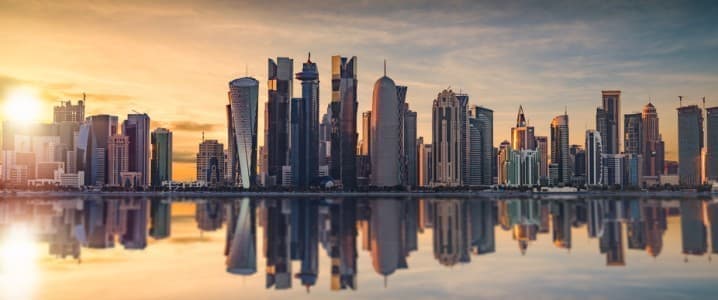Gulf countries, led by Saudi Arabia and the UAE, are investing heavily in carbon capture, utilization and storage (CCUS) and hydrogen projects to reduce carbon emissions and capitalize on the growing demand for clean energy.
The Middle East has the potential to become a global leader in CCUS and hydrogen production, thanks to its abundant natural resources, low-cost solar energy, and supportive government policies.
While CCUS and hydrogen offer promising solutions for decarbonization, concerns remain about the scalability and long-term viability of these technologies.
As hydrocarbons producers reap sustained revenue from high global prices, national oil companies (NOCs) in the Gulf are accelerating investment in carbon capture, utilisation and storage (CCUS); hydrogen; and cleaner sources of energy to make their activities less carbon-intensive and support the energy transition.
Gulf NOCs’ low-cost production advantages and massive hydrocarbons resources mean that CCUS can reduce emissions for the coming decades as the world continues to rely on oil and gas amid the energy transition. Moreover, with the cheapest solar energy in the world, an abundance of wind energy and ample land on which to build green energy generation projects, Gulf NOCs could establish an early-mover advantage in green hydrogen production and export, potentially bringing in $200bn in revenue by 2050, according to a report published in June 2021 by consultancy Roland Berger and Dii Desert Energy, a public-private network focused on the energy transition.
Carbon Capture
CCUS allows hydrocarbons companies to remove carbon from production processes, which can either be stored, redeployed in enhanced oil recovery techniques or transformed into other consumer goods. The segment is gaining momentum as user end-markets demand cleaner energy sources and carbon-trading markets. As of March 2023 there were 569 CCUS projects in various stages of development around the world, with 47 operational and 364 due to be running by 2030. However, these initiatives fall short of affecting global climate goals. A July 2023 analysis by the International Energy Agency found that 1.2bn tonnes per annum (tpa) of CCUS capacity is needed by 2030 to reach net-zero emissions goals by 2050.
Since many of these ventures are being undertaken by Gulf NOCs, they present a test case for the global uptake of CCUS technology. According to Mitsubishi Heavy Industries, which is involved in numerous power generation projects in the region, the Middle East could generate 50m tpa by 2030 – forecasts for the global total in 2030 vary from 80m to 89m tpa. According to the Global CCS Institute, Qatar, the UAE and Saudi Arabia captured 3.7m tpa of carbon in 2022, or 10% of the global total, and the think tank estimated that the GCC could reach 60m tpa by 2035.
In a boost to the uptake of CCUS, in September 2021 Saudi Arabia launched a platform for MENA nations to trade carbon offsets and credits. These ambitions aside, there is concern from international stakeholders about the overreliance on CCUS to meet its net-zero plans due to the need for major technological advancements in this area and because CCUS potentially provides cover for the continued production of oil rather than encouraging the shift to clean energy sources.
Hydrogen
Gulf NOCs are also investing in hydrogen, a cleaner fuel and energy source that can be generated from hydrocarbons or green energy resources and used locally or exported. Like CCUS, hydrogen has gained significant momentum in recent years. Saudi Arabia already has functioning hydrogen projects as well as ambitious plans for expansion. In March 2022 it started construction on the $5bn wind- and solar-powered hydrogen plant at its NEOM mega-project, which will be the largest hydrogen plant in the world upon completion, producing 650 tonnes per day. In October 2021 Saudi Arabia announced its aim to become the world’s largest hydrogen producer and is targeting 2.9m tpa by 2030 and 4m tpa by 2035. Other Gulf countries, such as the UAE, Kuwait and Oman, are developing national hydrogen strategies, though Qatar does not plan to produce hydrogen itself, as its gas will be used to power electrolysers abroad. In May 2022 Abu Dhabi National Oil Company (ADNOC) announced a new energy partnership with UK oil and gas major BP to develop hydrogen facilities in both the UAE and the UK. ADNOC is set to acquire a stake in BP’s H2Teesside hydrogen project, while the former will invest in ADNOC’s green hydrogen plant at Abu Dhabi’s Masdar. ADNOC is also looking at developing a green hydrogen supply chain with Japan.
By Oxford Business Group
More Top Reads From Oilprice.com:
Africa Emerges as Focal Point in Global Oil and Gas ExplorationCentral Asian Giants Target $10 Billion in Annual TradeUK Fund Faces Headwinds as Energy Storage Challenges Emerge
>>> Read full article>>>
Copyright for syndicated content belongs to the linked Source : OilPrice – https://oilprice.com/Energy/Energy-General/Gulf-Oil-Producers-Invest-Heavily-in-Carbon-Capture-and-Hydrogen.html




















![Forest ecology cannot be reduced to arithmetic, says M.I. Varghese [Interview] – Mongabay-India](https://earth-news.info/wp-content/uploads/2025/12/328946-forest-ecology-cannot-be-reduced-to-arithmetic-says-mi-varghese-interview-mongabay-india-350x250.jpg)










![Forest ecology cannot be reduced to arithmetic, says M.I. Varghese [Interview] – Mongabay-India](https://earth-news.info/wp-content/uploads/2025/12/328946-forest-ecology-cannot-be-reduced-to-arithmetic-says-mi-varghese-interview-mongabay-india-120x86.jpg)